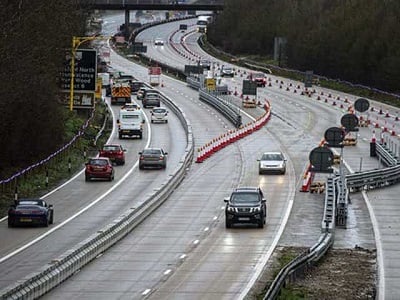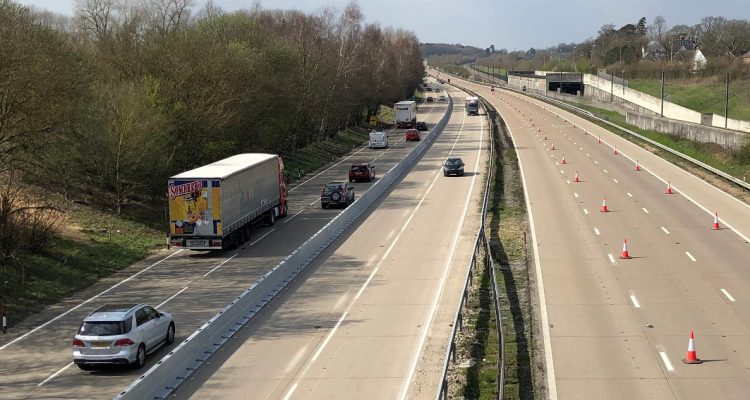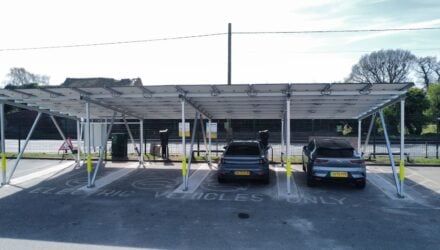The barrier, which can be installed on the motorway as part of measures to keep traffic moving on M20 if there is disruption in the county, is currently being stored on the London-bound hard shoulder but will be relocated to the central reservation.
National Highways will be carrying out an extensive drainage upgrade, groundwork to enable storage of the movable barrier and signage installation in the central reservation and London-bound verge to move the Brock barrier, which forms part of the Brock contraflow system, between junctions 8 (Maidstone) and 9 (Ashford) of the M20. Work is due to start overnight tonight (Friday 28 January) and will last up to 12 months.
 The current arrangement, which was last used in April 2021, uses the moveable barrier to allow the Brock contraflow system to be activated on the M20 London-bound carriageway, should the coastbound carriageway be required for queuing port-bound freight. This keeps the M20 open for use rather than traffic diverting onto other roads.
The current arrangement, which was last used in April 2021, uses the moveable barrier to allow the Brock contraflow system to be activated on the M20 London-bound carriageway, should the coastbound carriageway be required for queuing port-bound freight. This keeps the M20 open for use rather than traffic diverting onto other roads.
The work to move the barrier will take place in phases, and to carry it out safely, lane closures and a small number of overnight closures will be needed. These will be notified in advance.
National Highways head of operational integration Nicky Potts said: “Storing the moveable barrier on the M20 London-bound hard shoulder was only a temporary measure. We are about to start work to move it onto the central reservation, its permanent home, which will allow the hard shoulder between Ashford and Maidstone to be re-instated to its original width.
“This involves extensive construction work along the 13-mile stretch which will take up to a year. It will be carried out in phases, moving from Maidstone to Ashford. Road users will see the barrier in place on the London-bound M20, but it will be used as a safety barrier. If there is a reason to use the contraflow system as part of Operation Brock, it can still be easily deployed.
“I understand that this news will not be welcome by some people in Kent, but we will do everything we can to minimise the impact on road users, and I ask them to please bear with us while we carry out this important work.”

The M20 moveable barrier is being used while work is taking place on the central reservation, but the contraflow arrangement can be easily deployed in the event of disruption at the ports
Starting tonight (28th January), and until October 2022, the moveable barrier will be used as a traffic management barrier on the London-bound carriageway, while this work takes place. This does not mean the Brock contraflow system will be active, but it will provide a more efficient and cost-effective way of being able to deploy the contraflow quickly and effectively should it be required.
Dover TAP (traffic assessment project) has been used recently to manage traffic heading for the Port of Dover to help reduce traffic congestion in the town. Its deployment is agreed jointly between Port of Dover and National Highways in the event of disruption heading towards the port. The deployment of Dover TAP is unrelated to the work to relocate the Operation Brock barrier.
The following closures will be needed to relocate the movable barrier:
Overnight closures
Full closure: The M20 will be closed in both directions between junctions 9 and 8 from 8pm on Friday 28 January 2022 to 6am on Saturday 29 January 2022.
A small number of further overnight closures will be required, and once these dates have been confirmed, and these will be communicated through the National Highways website and email updates.
When the road is closed overnight, a clearly signed diversion route, will be in place along the A20 to help road users reach their destination. Over-height vehicles should use the A2, M2 and A249.
Lane closures
From Saturday 29 January 2022 lane closures will be in place between junctions 8 and 9 on both the London-bound and coastbound carriageways for around 40 weeks.
London-bound M20: the outside two lanes will be closed using the moveable barrier. Work will start at junction 9 and then extend the barrier towards junction 8. The barrier will increase in length as the work progresses. The hard shoulder will be in use, so there will be two lanes running London-bound, and a 50-mph speed restriction will be in place when the lanes are closed.
Coastbound carriageway: the outside lane will be closed using cones, and will only be closed when work is taking place. Where the outside lane is closed, there will be a 50-mph speed limit in place.
National Highways will tell road users in advance wherever possible if the road needs to close overnight. Closure dates are subject to change in the case of adverse weather or other unplanned events. It will be possible to deploy the Operation Brock contraflow using the barrier if needed.
People wishing to keep up to date on the work can visit the website: https://nationalhighways.co.uk/our-work/south-east/south-east-maintenance-schemes/ or sign up to be kept informed via email: [email protected]



















